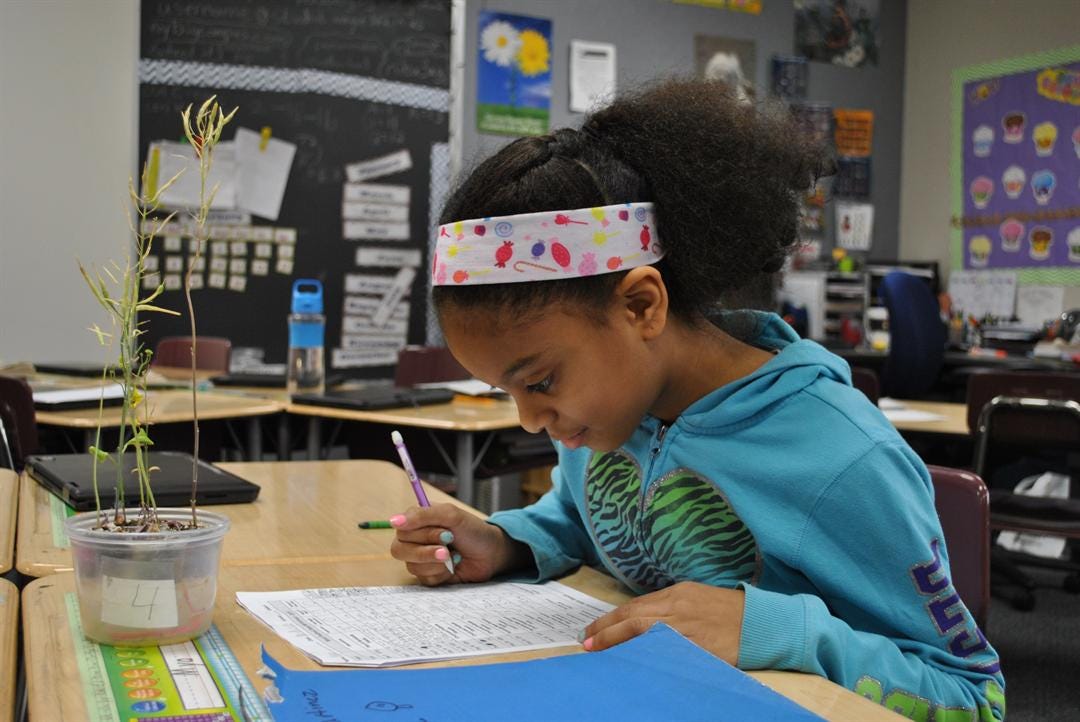Dow Agro Shares Science with Half-a-Million
 Lang-Martinez says
Lang-Martinez says
Subscriber Benefit
As a subscriber you can listen to articles at work, in the car, or while you work out. Subscribe NowFourth grade student Mya Lang-Martinez is just hours away from knowing if her hypothesis was correct, and her anticipation bubbles over as it likely would for a “grownup” scientist. In an exclusive with Inside INdiana Business, Indianapolis-based Dow AgroSciences is announcing that Lang-Martinez represents the 500,000th person the company has connected with in its science outreach efforts. It’s fitting the half-million milestone is a budding scientist—who Dow AgroSciences hopes will blossom into tomorrow’s plant biologist.
“We hope [the kids] will have an interest that’s strong enough to carry them through studying a STEM subject and going into a STEM industry,” says Dow AgroSciences Patent Liaison and Science Ambassadors Co-Chair Ronda Hamm. “We want to instill that passion and desire to learn and practice science.”
Hamm leads a team of more than 400 Dow AgroSciences employees who volunteer as Science Ambassadors, helping Hoosiers connect to STEM topics through events that range from the Indiana State Fair to local school science nights. Over the course of five years, the company says it has delivered its message to 500,000 people in Central Indiana.
Seeking to make science fun for the youngest crop of Hoosiers, the company is leading a project with hundreds of fourth graders in the Metropolitan School District of Wayne Township. The students spent the winter growing Arabidopsis plants in specially-lit “grow boxes” that act as miniature greenhouses.
Called the “Cool Green Seed Festival,” the three-month project is more than just watching a plant grow. The program teaches them about seed production; small teams of students start with seeds, analyze the plants’ growth, then measure how many seeds each plant produces in its pods.
“They are so excited about the project,” says Wayne Township Fourth Grade Teacher Jane Nicholls. “They remind me daily that they need to check their plants. They get to touch it, smell it—we use all of our senses to make observations. They’re just so excited and involved, because they have a stake in it; they want to make sure their plants grow.”
Nicholls says the rapidly-growing plants allow students to see the entire life cycle, introducing the concept that just two seeds can yield many more.
“We counted how many flowers and seed pods there were, checked the temperature [in the grow box] and kept track of how tall they grew every time we saw them,” says Lang-Martinez. “My favorite part was when we touched the roots at the bottom.”
The students used the scientific method—making a hypothesis, conducting an experiment and finding a conclusion—to learn about seed production and what Dow AgroSciences does on a much grander scale.
“We want them to know science is not hard—it’s fun, and it’s surprising. A lot of the students are really surprised by how many seeds the plant produces,” says Hamm. “In the real world, the same thing happens to scientists every day; you think you might know what the answer is going to be, you have a hypothesis—but inevitably—it’s completely surprising and different.”
Each class also nominates a student to spend a day at Dow AgroSciences’ headquarters, meeting real-life scientists and discussing their findings about the Arabidopsis plants’ seed production.
“On a big picture scale, we have to figure out how to feed 9 billion people around the world by 2050 with fewer resources than we have today. The only way we’re going to achieve that is through the continual advancement of technologies and STEM workers,” says Dow AgroSciences Coaching/Project Leader and Science Ambassadors Co-Chair Amber Maynard. “The earlier we can get kids involved—and by extension, their parents and community at large—the better off we’re going to be.”
Person number 500,000 is a small victory for Dow AgroSciences; Lang-Martinez says she wants to be a scientist when she grows up. The agricultural giant is hopeful it’s planted many more seeds that will produce the next crop of workers with a passion for science.
Hamm says the students’ curiosity and excitement are contagious.
Hamm says helping kids “get their hands dirty” brings science to life.
Maynard says even fourth graders can grasp advanced scientific concepts on a basic level.
